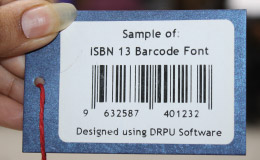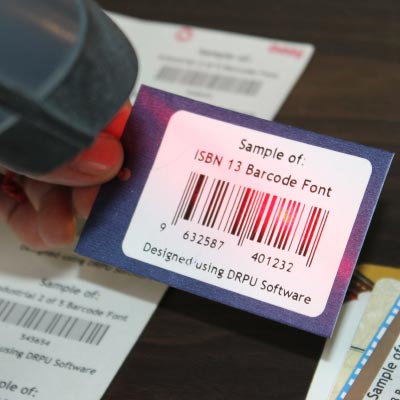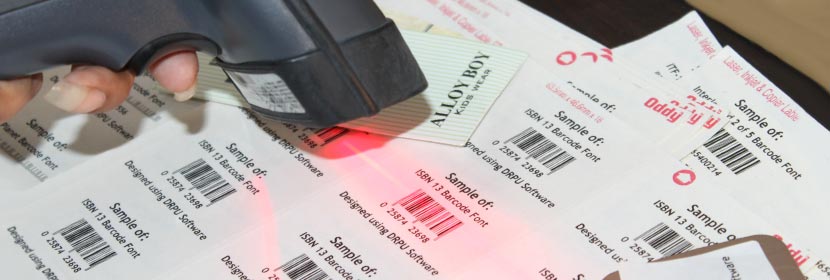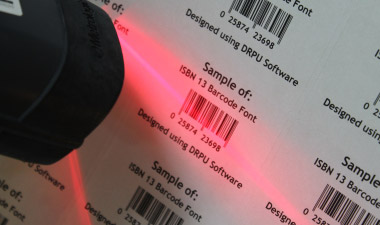ISBN 13 Barcode System
An ISBN-13 barcode is a type of barcode used to identify books and other printed materials. The barcode is based on the International Standard Book Number (ISBN), which is a unique identifier assigned to each book or edition of a book. The ISBN-13 barcode is a variation of the European Article Number (EAN) barcode, and consists of a series of bars and spaces that represent the ISBN number in machine-readable form.

◆ The ISBN-13 barcode is a 13-digit code that is used to identify books and other printed materials worldwide. The first three digits of the barcode represent the prefix, which identifies the country or geographic region of the publisher. The next group of digits represents the publisher identifier, followed by the title identifier and a check digit. The check digit is calculated using a mathematical formula based on the other digits in the barcode, and is used to ensure the accuracy of the barcode.
◆ The ISBN-13 barcode is an important tool for publishers, booksellers, and libraries, as it allows for efficient tracking and inventory management of books and other printed materials. By scanning the barcode, booksellers and librarians can quickly retrieve information about the book, such as the author, title, publisher, and edition, as well as pricing and availability information.
◆ To create an ISBN-13 barcode, publishers must first obtain an ISBN number from the appropriate ISBN agency in their country or region. The ISBN number is a unique identifier assigned to each edition of a book, and consists of a prefix that identifies the country or region of the publisher, followed by a publisher identifier, title identifier, and check digit. Once the ISBN number has been assigned, publishers can create a barcode using specialized software or a barcode generator tool.
ISBN 13 Barcode Different from other Barcode Types
The International Standard Book Number (ISBN) is a unique identifier for books and other printed materials, and the ISBN 13 barcode is the machine-readable representation of this identifier. While the basic function of all barcodes is to identify and track products, there are many different types of barcodes with varying structures and capabilities. In this article, we will explore the key differences between the ISBN 13 barcode and other types of barcodes.

-
01Structure
One of the primary differences between the ISBN 13 barcode and other barcodes is its structure. The ISBN 13 barcode is based on the EAN-13 barcode standard, which consists of 13 digits. The first three digits represent the country or language of origin, the next group of digits represents the publisher, and the final group of digits represents the specific book or edition. The ISBN 13 barcode also includes a check digit, which is used to verify the accuracy of the barcode. This structure allows for efficient identification and tracking of books and other printed materials.
In contrast, other types of barcodes may have different structures depending on their intended use. For example, UPC barcodes, which are commonly used in retail settings, consist of 12 digits and are primarily used to identify and track consumer goods. QR codes, on the other hand, can contain much more information and are often used to link to websites, product information, or other digital content.
-
02
Industry-specific applications
Another difference between the ISBN 13 barcode and other types of barcodes is their industry-specific applications. While the ISBN 13 barcode is primarily used in the book publishing industry, other types of barcodes may be more common in other industries. For example, the GS1-128 barcode is widely used in the shipping and logistics industry to track packages and pallets, while the Code 39 barcode is commonly used in manufacturing and inventory management..
-
03Readability
The readability of a barcode refers to the ability of a barcode scanner to accurately and quickly decode the barcode. The ISBN 13 barcode is designed to be highly readable, and can be easily scanned by most barcode scanners. Other types of barcodes, such as stacked barcodes or 2D barcodes, may be less readable depending on the type of scanner and the quality of the barcode image.
-
04Data
capacity
Another key difference between the ISBN 13 barcode and other barcodes is their data capacity. The ISBN 13 barcode is designed to encode a specific set of information, including the country of origin, publisher, and book title. Other types of barcodes, such as QR codes or Data Matrix codes, can contain much more information, including text, images, and links to websites.
-
05Cost
The cost of implementing a barcode system can vary depending on the type of barcode and the specific application. The ISBN 13 barcode is widely used in the book publishing industry and is therefore relatively inexpensive to implement. Other types of barcodes, such as RFID tags, may be more expensive to implement but offer additional capabilities such as real-time tracking and inventory management.
-
06International
standardization
One of the key advantages of the ISBN 13 barcode is its international standardization. The ISBN system is used around the world as a standardized way to identify and track books and other printed materials. This means that publishers, booksellers, libraries, and other organizations can easily share information and conduct business across national borders. Other types of barcodes may not be as widely adopted internationally and may be more difficult to use in global supply chains.
In conclusion, the ISBN 13 barcode is a unique type of barcode that is widely used in the book publishing industry to identify and track books and other printed materials.
Minimum And Maximum Length Of An ISBN 13 Barcode
The International Standard Book Number (ISBN) is a unique identifier for books and other printed materials, and the ISBN 13 barcode is the machine-readable representation of this identifier. The ISBN 13 barcode is based on the EAN-13 barcode standard, which consists of 13 digits. In this article, we will explore the minimum and maximum length of an ISBN 13 barcode.

Minimum Length: The minimum length of an ISBN 13 barcode is 13 digits. The first three digits of the barcode represent the country or language of origin, followed by the publisher code, and finally the title or edition of the book. The last digit of the barcode is a check digit, which is calculated based on a formula that ensures the accuracy of the barcode. The ISBN 13 barcode is designed to be highly readable, and can be easily scanned by most barcode scanners.
Maximum Length: The maximum length of an ISBN 13 barcode is also 13 digits. While other types of barcodes may be able to encode more information, the ISBN 13 barcode is specifically designed to encode the ISBN number of a book or other printed material. The structure of the ISBN 13 barcode is based on the EAN-13 barcode standard, which is used for a wide range of consumer goods and other products. The EAN-13 barcode is capable of encoding up to 13 digits, which allows for efficient identification and tracking of products.
It is important to note that the ISBN 13 barcode is not the only type of barcode that can be used to identify and track books and other printed materials. Other types of barcodes, such as the ISBN 10 barcode or the UPC barcode, may also be used in certain applications. However, the ISBN 13 barcode is widely recognized as the standard for book identification and is used by publishers, booksellers, libraries, and other organizations around the world.
In conclusion, the minimum and maximum length of an ISBN 13 barcode is 13 digits. The structure of the ISBN 13 barcode is based on the EAN-13 barcode standard, which allows for efficient identification and tracking of books and other printed materials. While other types of barcodes may be able to encode more information, the ISBN 13 barcode is specifically designed to encode the ISBN number of a book or other printed material and is widely recognized as the standard for book identification.
How do I generate an ISBN 13 barcode?
Generating an ISBN-13 barcode involves several steps, including obtaining an ISBN number, determining the check digit, selecting a barcode symbology, and generating the barcode image. In this article, we will explore these steps in detail to help you generate an ISBN-13 barcode.
-
Step 1: Obtain an ISBN number
The first step in generating an ISBN-13 barcode is obtaining an ISBN number. This number is assigned to each book by the International Standard Book Number Agency (ISBN Agency) and serves as a unique identifier for the book. ISBN numbers can be obtained from the agency in your country or region.
-
Step 2: Determine the check digit
The ISBN-13 barcode includes a check digit that is used to verify the accuracy of the barcode. The check digit is calculated based on the other 12 digits of the ISBN number using a specific formula. To determine the check digit for an ISBN-13 barcode, follow these steps:
⬗ The result of step 5 is the check digit. For example, if the ISBN number is 978-0-12-345678-9, the check digit would be calculated as follows: Add together the first, third, fifth, seventh, ninth, and eleventh digits of the ISBN number. {9 + 8 + 0 + 3 + 4 + 6 = 30}
⬗ Multiply this sum by 3. {30 x 3 = 90}
⬗ Add together the second, fourth, sixth, eighth, tenth, and twelfth digits of the ISBN number. {7 + 1 + 2 + 5 + 7 + 8 = 30}
⬗ Add the results of steps 2 and 3 together.{90 + 30 = 120?}
⬗ Subtract the result of step 4 from the next highest multiple of 10.{130 - 120 = 10} In this case, the check digit is 0.
-
Step 3: Select a barcode symbology
The next step in generating an ISBN-13 barcode is selecting a barcode symbology. The most commonly used symbology for ISBN-13 barcodes is the EAN-13 symbology, which encodes the 13-digit number as a series of bars and spaces. Other symbologies that can be used include Code 128 and Code 39, but these are less commonly used for ISBN-13 barcodes.
-
Step 4: Generate the barcode image
Once you have obtained an ISBN number, determined the check digit, and selected a barcode symbology, the final step is to generate the barcode image. This can be done using specialized barcode software or online barcode generators.
-
To generate an ISBN-13 barcode using barcode software, follow these steps:

Open the barcode software and select the appropriate barcode symbology (EAN-13).
Enter the 13-digit ISBN number (including the check digit) into the software.
Adjust the size and resolution of the barcode image as needed.
Save the barcode image as a file, or print it directly from the software.
-
To generate an ISBN-13 barcode using an online barcode generator, follow these
steps:
Navigate to an online barcode generator that supports EAN-13 barcodes.
Enter the 13-digit ISBN number (including the check digit) into the generator.
Adjust the size and resolution of the barcode image as needed.
Generate the barcode image and save it as a file, or print it directly from the website.
Types Of Barcode Symbologies Used In ISBN
-
❖ There are a number of different types of barcode symbologies that can be used to encode the ISBN number, including EAN-13, UPC, Code 39, and Code 128. However, the most common symbology used for ISBN-13 barcodes is the EAN-13 symbology, which is a variation of the Universal Product Code (UPC) barcode used for retail products.
-
❖ The EAN-13 barcode is a 13-digit code that consists of a series of bars and spaces that represent the ISBN number in machine-readable form. The barcode is created using a barcode software program or a barcode generator tool, which converts the ISBN number into a series of bars and spaces that can be read by a barcode scanner.
-
❖ To use an ISBN-13 barcode, booksellers and librarians must have a barcode scanner or reader that is compatible with the EAN-13 symbology. Most modern barcode scanners and readers are able to read EAN-13 barcodes, making it a widely accepted and standardized format for identifying books and other printed materials.
In summary, the ISBN-13 barcode is a 13-digit code used to identify books and other printed materials worldwide. It is based on the International Standard Book Number (ISBN), which is a unique identifier assigned to each edition of a book. The ISBN-13 barcode is created using specialized software or a barcode generator tool, and is encoded using the EAN-13 symbology. The barcode allows for efficient tracking and inventory management of books and other printed materials, and is widely accepted and standardized in the publishing industry.